Hot Deformation Behavior and Processing Map Considering Strengthening Effect for Al–10.0Zn–3.0Mg–2.8Cu Alloy
Abstract
:1. Introduction
2. Materials and Methods
3. Hot Deformation Behavior
3.1. Constitutive Model
3.2. Hot Processing Map
4. Results and Discussion
4.1. Microstructure Characteristics within Hot Processing Map
4.2. Optimization of Hot Processing Map Considering the Insoluble Phase
4.3. Verification of Optimal Hot Processing Region
5. Conclusions
- (1)
- The Arrhenius constitutive model was developed to describe the deformation behavior of Al–10.0Zn–3.0Mg–2.8Cu alloy during hot compression. The activation energy (Q) was 160.43 kJ/mol (380–460 °C, 0.001–1 s−1). The optimal hot processing region of the hot processing map at 0.9 strain is 431–456 °C and 0.004–0.108 s−1.
- (2)
- Under low strain rate (0.001 s−1), the softening mechanism includes DRV and DRX. Both CDRX and DDRX mechanisms exist in hot compression. At the low temperature (380 °C), CDRX is composed of PSN and grain boundary bulging nucleation. The PSN effect is weakened as the deformation temperature rises.
- (3)
- The strain rate can be optimized close to 0.1 s−1 according to the evolution rule of the insoluble phase. The particles were refined by dislocation to assist in consuming work hardening when the strain rate increased from 0.001 to 0.1 s−1. The dissolving degree of insoluble particles increases gradually, which leads to the increase of microhardness of the alloy after aging.
- (4)
- The hot processing region considering strengthening effect was optimized at 431–456 °C and the strain rate approaches 0.1 s−1. This will provide theoretical support for the subsequent deformation and engineering application of Al–10.0Zn–3.0Mg–2.8Cu alloy and opens up a new research idea to find the hot deformation processing for such alloys.
Author Contributions
Funding
Institutional Review Board Statement
Informed Consent Statement
Data Availability Statement
Acknowledgments
Conflicts of Interest
References
- Hirsch, J.; Al-Samman, T. Superior light metals by texture engineering: Optimized aluminum and magnesium alloys for automotive applications. Acta Mater. 2013, 61, 818–843. [Google Scholar] [CrossRef]
- Hou, Y.Z.; Chen, L.; Li, Z.G.; Zhao, G.Q.; Zhang, C.S. Effects of artificial aging on microstructure, mechanical properties and stress corrosion cracking of a novel high strength 7A99 Al alloy. Mater. Sci. Eng. A 2020, 780, 139217. [Google Scholar] [CrossRef]
- Kheradmand, A.B.; Tayebi, M.; Akbari, M.M. Effect of quench-controlled precipitation hardening on microstructure and me-chanical properties of Al-Zn-Mg-Cu-Zr alloys contain of Sc micro-alloying. J. Alloys Compd. 2022, 902, 163748. [Google Scholar] [CrossRef]
- Amiri, M.M.; Fereshteh, S.F. Influence of roll speed difference on microstructure, texture and mechanical properties of 7075 aluminum plates produced via combined continuous casting and rolling process. Trans. Nonferrous Met. Soc. China 2021, 31, 901–912. [Google Scholar] [CrossRef]
- Azarniya, A.; Taheri, A.K.; Taheri, K.K. Recent advances in ageing of 7xxx series aluminum alloys: A physical metallurgy perspective. J. Alloys Compd. 2019, 781, 945–983. [Google Scholar] [CrossRef]
- Peng, Y.H.; Liu, C.Y.; Wei, L.L.; Jiang, H.J.; Ge, Z.J. Quench sensitivity and microstructures of high-Zn-content Al−Zn−Mg−Cu alloys with different Cu contents and Sc addition. Trans. Nonferrous Met. Soc. China 2021, 31, 24–35. [Google Scholar] [CrossRef]
- Yuan, D.L.; Chen, S.Y.; Chen, K.H.; Huang, L.P.; Chang, J.Y.; Zhou, L.; Ding, Y.F. Correlations among stress corrosion cracking, grain-boundary microchemistry, and Zn content in high Zn-containing Al–Zn–Mg–Cu alloys. Trans. Nonferrous Met. Soc. China 2021, 31, 2220–2231. [Google Scholar] [CrossRef]
- Lu, Z.; Yang, S.J.; Jiang, H.F.; Lu, J. A study of melting-casting process of a new type ultra-high strength aluminum alloy. J. Aeronaut. Mater. 2000, 20, 30–33. [Google Scholar]
- Wu, R.; Liu, Y.; Geng, C. Study on hot deformation behavior and intrinsic workability of 6063 aluminum alloys using 3D processing map. J. Alloys Compd. 2017, 713, 212–221. [Google Scholar] [CrossRef]
- Ke, B.; Ye, L.Y.; Tang, J.G.; Zhang, Y.; Liu, S.D.; Lin, H.Q.; Dong, Y.; Liu, X.D. Hot deformation behavior and 3D processing maps of AA7020 aluminum alloy. J. Alloys Compd. 2020, 845, 156113. [Google Scholar] [CrossRef]
- Shi, G.H.; Zhang, Y.A.; Liu, H.L.; Li, X.W.; Wang, G.J.; Li, Z.H.; Yan, L.Z.; Wen, K.; Xiong, B.Q. Constructing processing maps for hot deformation and microstructural evolution of Al–Zn–Mg–Cu alloys. Mater. Res. Express 2019, 6, 096566. [Google Scholar] [CrossRef]
- Zhao, J.H.; Deng, Y.L.; Tang, J.G.; Zhang, J. Influence of strain rate on hot deformation behavior and recrystallization behavior under isothermal compression of Al-Zn-Mg-Cu alloy. J. Alloys Compd. 2019, 809, 151788. [Google Scholar] [CrossRef]
- Bai, P.C.; Hou, X.H.; Zhang, X.Y.; Zhao, C.W.; Xing, Y.M. Microstructure and mechanical properties of a large billet of spray formed Al–Zn–Mg–Cu alloy with high Zn content. Mater. Sci. Eng. A 2009, 508, 23–27. [Google Scholar] [CrossRef]
- Xu, C.; Furukawa, M.; Horita, Z.; Langdo, T.G. Using ECAP to achieve grain refinement, precipitate fragmentation and high strain rate superplasticity in a spray-cast aluminum alloy. Acta Mater. 2003, 51, 6139–6149. [Google Scholar] [CrossRef]
- Adam, K.F.; Long, Z.D.; Field, D.P. Analysis of particle-stimulated nucleation (PSN)-dominated recrystallization for hot-rolled 7050 aluminum alloy. Metall. Mater. Trans. A 2017, 48, 2062–2076. [Google Scholar] [CrossRef]
- Gupta, R.K.; Anil, V.; Saratth, A.; Niteshraj, J. Hot deformation behavior of aluminum alloys AA7010 and AA7075. J. Mater. Eng. Perform. 2019, 28, 5021–5036. [Google Scholar] [CrossRef]
- Zang, Q.H.; Yu, H.S.; Lee, Y.S.; Kim, M.S.; Kim, H.W. Effects of initial microstructure on hot deformation behavior of Al-7.9 Zn-2.7 Mg-2.0 Cu (wt%) alloy. Mater. Charact. 2019, 151, 404–413. [Google Scholar] [CrossRef]
- Chen, K.H.; Liu, H.W.; Liu, Y.Z. Effect of temperature-incremental solution heat treatment on the microstructure and mechanical properties of Al–Zn–Mg–Cu alloy. J. Cent. South Univ. Technol. 2000, 31, 339–341. [Google Scholar]
- Chen, K.; Liu, H.; Zhang, Z. The improvement of constituent dissolution and mechanical properties of 7055 aluminum alloy by stepped heat treatments. J. Mater. Process. Technol. 2003, 142, 190–196. [Google Scholar] [CrossRef]
- Toda, H.; Kobayashi, T.; Takahashi, A. Mechanical analysis of toughness degradation due to premature fracture of course inclusions in wrought aluminium alloy. Mater. Sci. Eng. A 2000, 280, 69–75. [Google Scholar] [CrossRef]
- Yang, X.B.; Chen, J.H.; Liu, J.Z.; Liu, P.; Qin, F.; Cheng, Y.L.; Wu, C.L. Spherical constituent particles formed by a multistage solution treatment in Al–Zn–Mg–Cu alloys. Mater. Charact. 2013, 83, 79–88. [Google Scholar] [CrossRef]
- Sellars, C.M.; Mctegart, W.J. On the mechanism of hot deformation. Acta Metall. 1966, 14, 1136–1138. [Google Scholar] [CrossRef]
- Li, N.; Zhao, C.Z.; Jiang, Z.H.; Zhang, H.X. Flow behavior and processing maps of high-strength low-alloy steel during hot compression. Mater. Charact. 2019, 153, 224–233. [Google Scholar] [CrossRef]
- Park, S.Y.; Kim, W.J. Difference in the hot compressive behavior and processing maps between the as-cast and homogenized Al-Zn-Mg-Cu (7075) alloys. J. Mater. Sci. Technol. 2016, 3, 660–670. [Google Scholar] [CrossRef]
- Santosh, S.; Praveen, R.; Sampath, V. Influence of Cobalt on the Hot Deformation Characteristics of an NiTi Shape Memory Alloy. Trans. Indian Inst. Met. 2019, 72, 1465–1468. [Google Scholar] [CrossRef]
- Santosh, S.; Sampath, V.; Mouliswar, R.R. Hot deformation characteristics of NiTiV shape memory alloy and modeling using constitutive equations and artificial neural networks. J. Alloys Compd. 2022, 901, 163451. [Google Scholar] [CrossRef]
- Babu, N.S.; Tiwari, S.B.; Nageseara, B. Modified instability condition for identification of unstable metal flow regions in processing maps of magnesium alloys. J. Mater. Sci. Technol. 2005, 21, 976–984. [Google Scholar] [CrossRef]
- Yang, S.L.; Shen, J.; Zhang, Y.A.; Li, Z.H.; Li, X.W.; Huang, S.H.; Xiong, B.Q. Processing maps and microstructural evolution of Al–Cu–Li alloy during hot deformation. Rare Met. 2019, 38, 1136–1143. [Google Scholar] [CrossRef]
- Zang, Q.H.; Yu, H.S.; Lee, Y.S.; Kim, M.S.; Kim, H.W. Hot deformation behavior and microstructure evolution of annealed Al-7.9 Zn-2.7 Mg-2.0 Cu (wt%) alloy. J. Alloys Compd. 2018, 763, 25–33. [Google Scholar] [CrossRef]
- Lang, Y.J.; Zhou, G.X.; Hou, L.G.; Zhang, J.S.; Zhuang, L.Z. Significantly enhanced the ductility of the fine-grained Al–Zn–Mg–Cu alloy by strain-induced precipitation. Mater. Des. 2015, 88, 625–631. [Google Scholar] [CrossRef]
- Jiang, H.; Dong, J.X.; Zhang, M.C.; Zheng, L.; Yao, Z.H. Hot deformation characteristics of Alloy 617B nickel-based superalloy: A study using processing map. J. Alloys Compd. 2015, 647, 338–350. [Google Scholar] [CrossRef]
- Rokina, M.R.; Zarei, A.; Roostaei, A.A.; Abolhasani, A. Constitutive base analysis of a 7075 aluminum alloy during hot compression testing. Mater. Des. 2011, 32, 4955–4960. [Google Scholar] [CrossRef]
- Lei, C.; Wang, Q.D.; Tang, H.P.; Liu, T.W. Hot deformation constitutive model and processing maps of homogenized Ale5Mge3Zne1Cu alloy. J. Mater. Res. Technol. 2021, 14, e339. [Google Scholar] [CrossRef]
- Jin, N.P.; Zhang, H.; Han, Y.; Wu, W.X.; Chen, J.H. Hot deformation behavior of 7150 aluminum alloy during compression at elevated temperature. Mater. Charact. 2009, 60, 530–536. [Google Scholar] [CrossRef]
- Liu, W.Y.; Zhao, H.; Li, D.; Zhang, Z.Q.; Huang, G.J.; Liu, Q. Hot deformation behavior of AA7085 aluminum alloy during isothermal compression at elevated temperature. Mater. Sci. Eng. A 2014, 596, 176–182. [Google Scholar] [CrossRef]
- Lin, Y.C.; He, D.G.; Chen, M.S.; Chen, X.M.; Zhao, C.Y.; Ma, X.; Long, Z.L. EBSD analysis of evolution of dynamic recrystallization grains and δ phase in a nickel-based superalloy during hot compressive deformation. Mater. Des. 2016, 97, 13–24. [Google Scholar] [CrossRef]
- He, D.G.; Lin, Y.C.; Jiang, X.Y.; Yin, L.X.; Wang, L.H.; Wu, Q. Dissolution mechanisms and kinetics of δ phase in an aged Ni-based superalloy in hot deformation process. Mater. Des. 2018, 156, 262–271. [Google Scholar] [CrossRef]
- Ren, X.W.; Huang, Y.C.; Zhang, X.Y.; Li, H.; Zhao, Y.X. Influence of shear deformation during asymmetric rolling on the microstructure, texture, and mechanical properties of the AZ31B magnesium alloy sheet. Mater. Sci. Eng. A 2021, 800, 140306. [Google Scholar] [CrossRef]
- Ren, X.W.; Zhang, X.Y.; Huang, Y.C.; Liu, Y.; Zhao, L.K.; Zhou, W.L. Evolution of shear texture during the asymmetric rolling and its annealing behavior in a twin-roll casting AA6016 sheet: An ex-situ electron backscatter diffraction study. J. Mater. Res. Technol. 2020, 9, 6420–6433. [Google Scholar] [CrossRef]
- Zhang, H.B.; Zhang, K.F.; Zhou, H.P.; Lu, Z.; Zhao, C.H.; Yang, X.L. Effect of strain rate on microstructure evolution of a nickel-based superalloy during hot deformation. Mater. Des. 2015, 80, 51–62. [Google Scholar] [CrossRef]
- Afifi, M.A.; Wang, Y.C.; Cheng, X.W.; Li, S.K.; Langdon, T.G. Strain rate dependence of compressive behavior in an Al-Zn-Mg alloy processed by ECAP. J. Alloys Compd. 2019, 791, 1079–1087. [Google Scholar] [CrossRef]
- Liao, Y.; Yan, H.G.; Xia, W.J.; Chen, J.H.; Su, B.; Li, X.Y.; Zhao, L. Effect of Heat Treatment on the Microstructure and Properties of High Strain Rate Rolled 7050 Aluminum Alloy. Met. Mater. Int. 2022, 28, 1014–1025. [Google Scholar] [CrossRef]
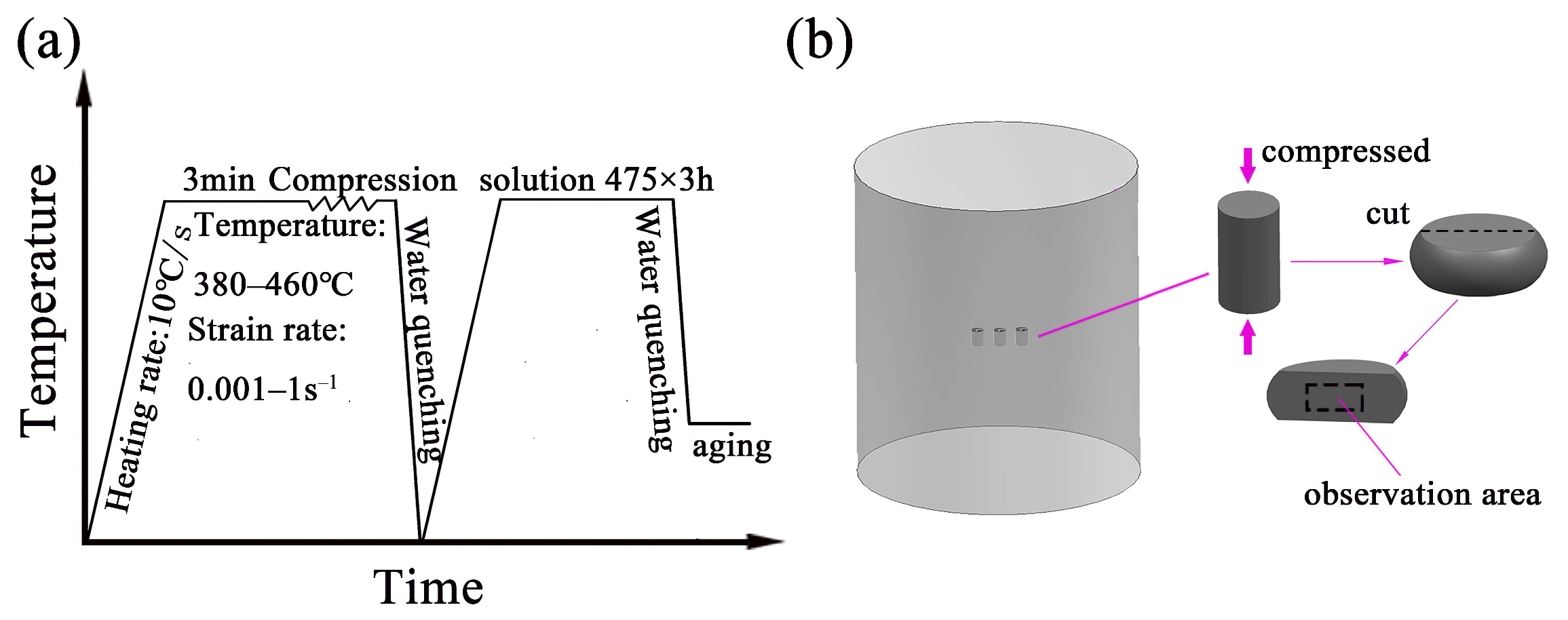
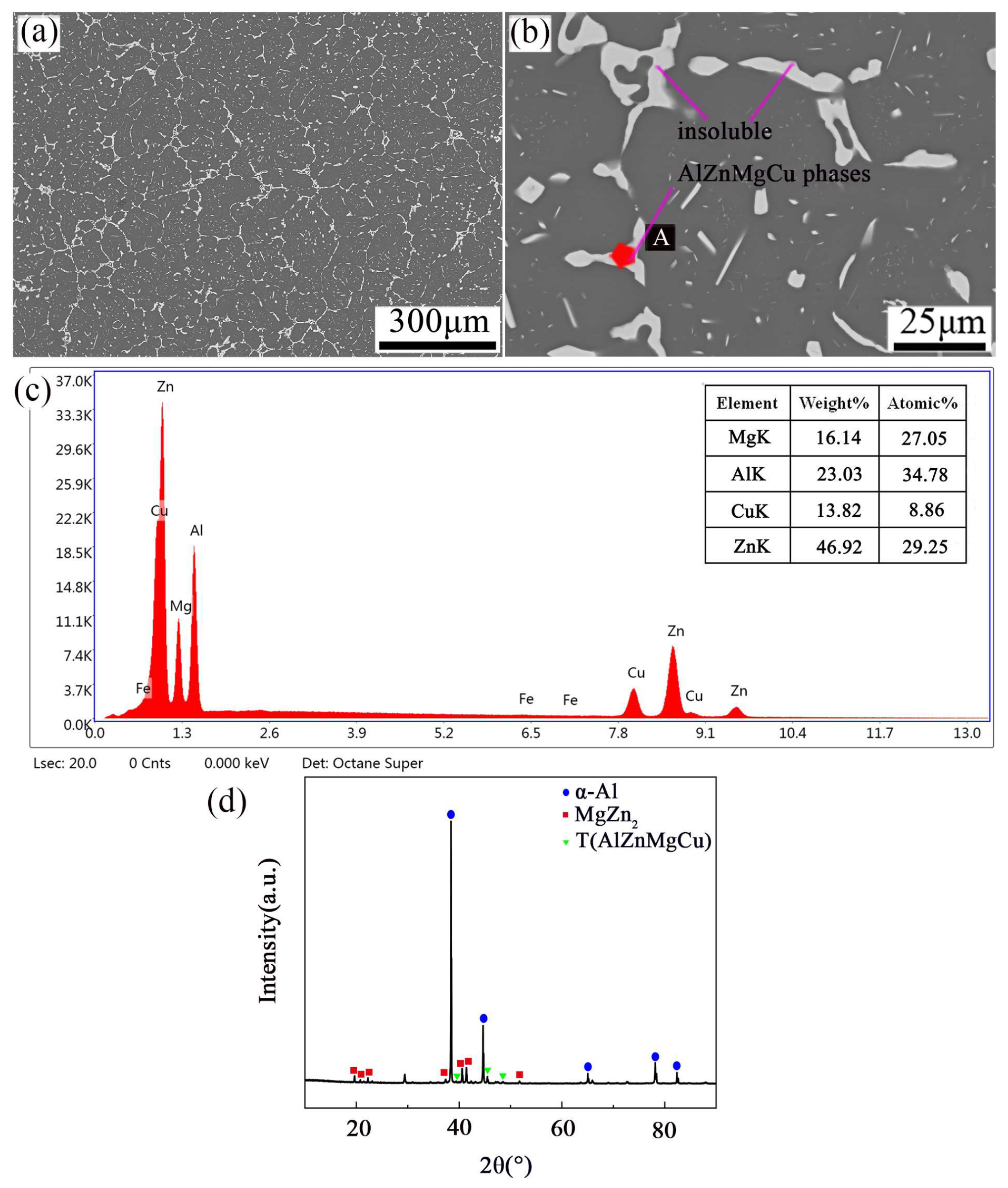
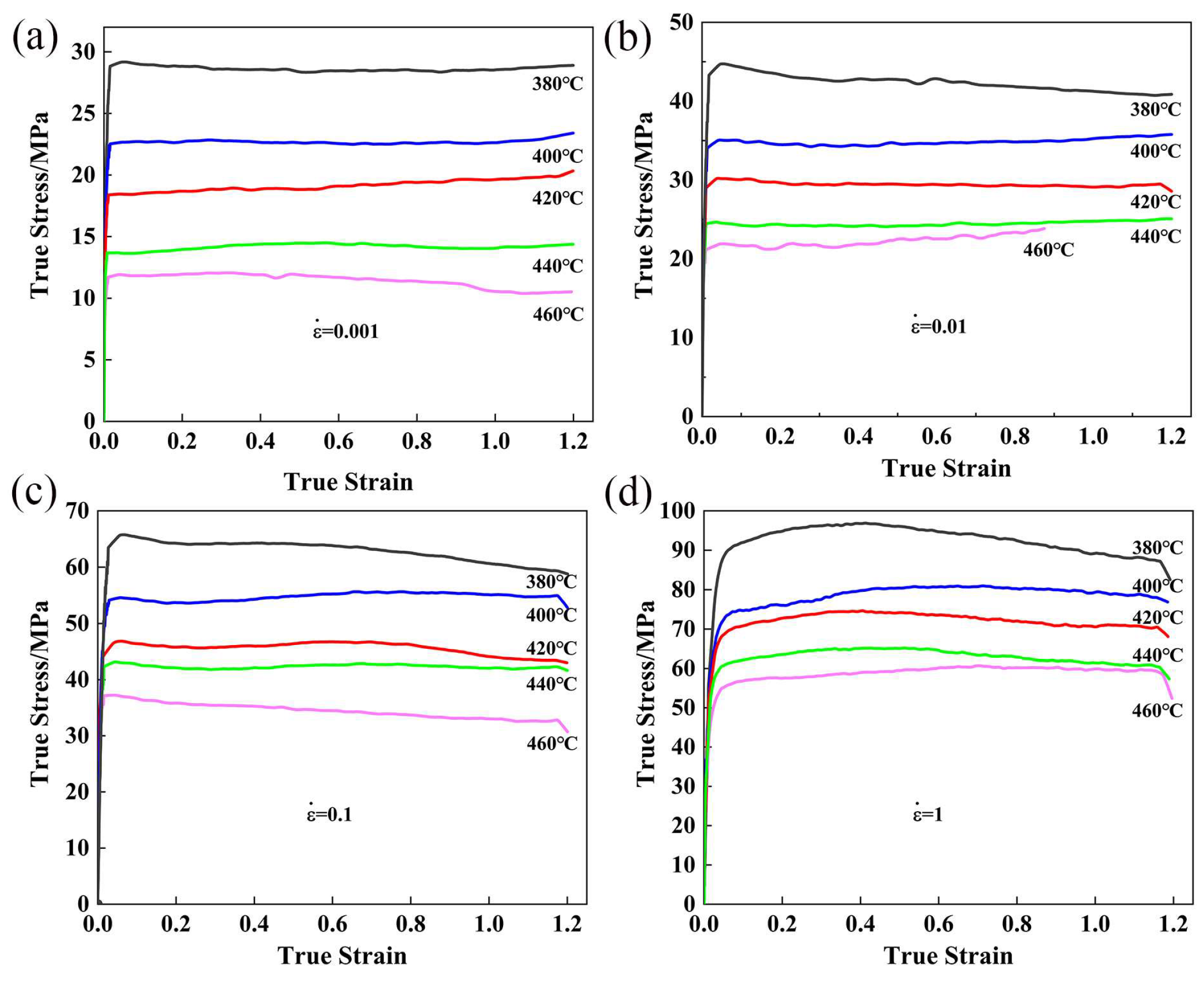
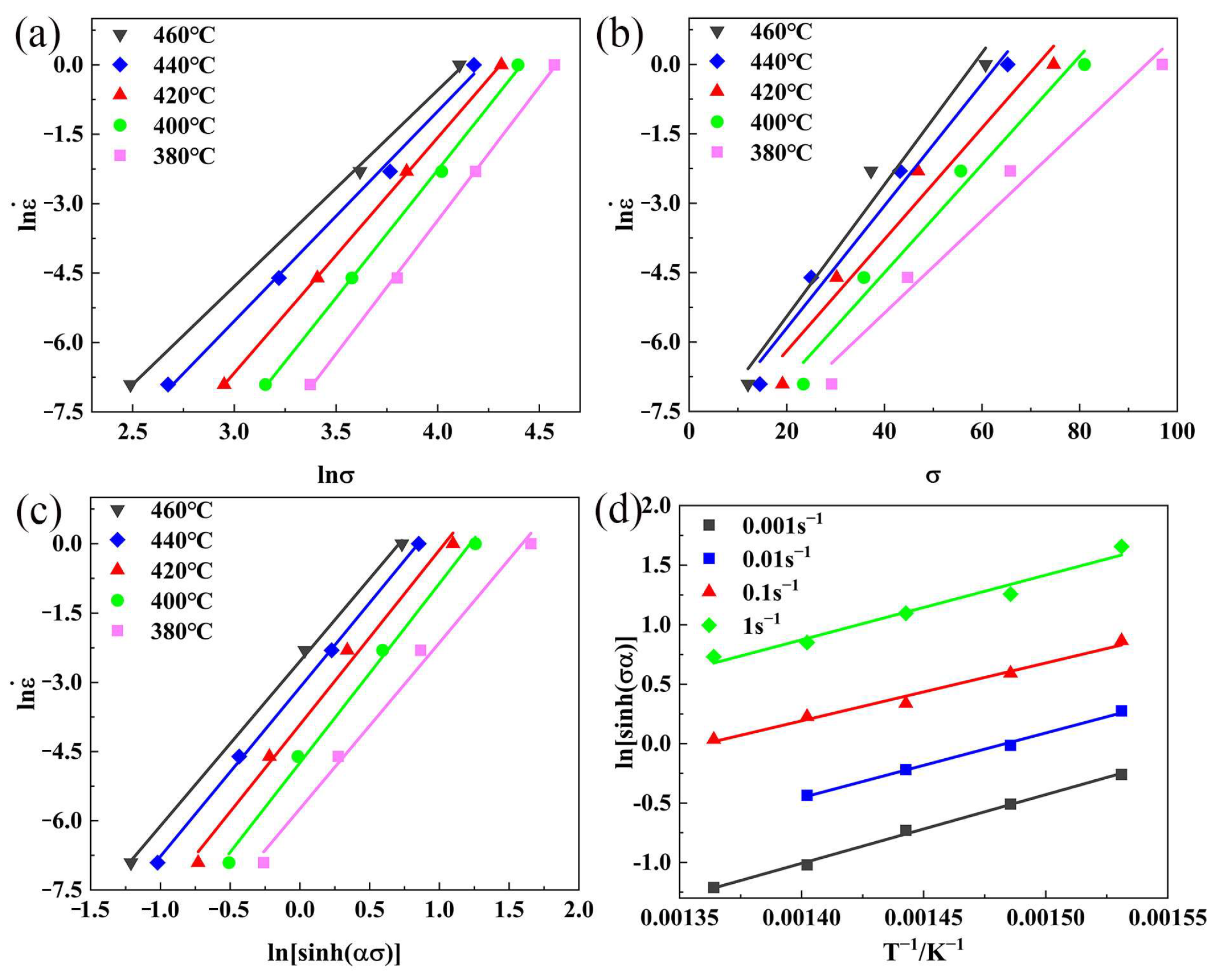
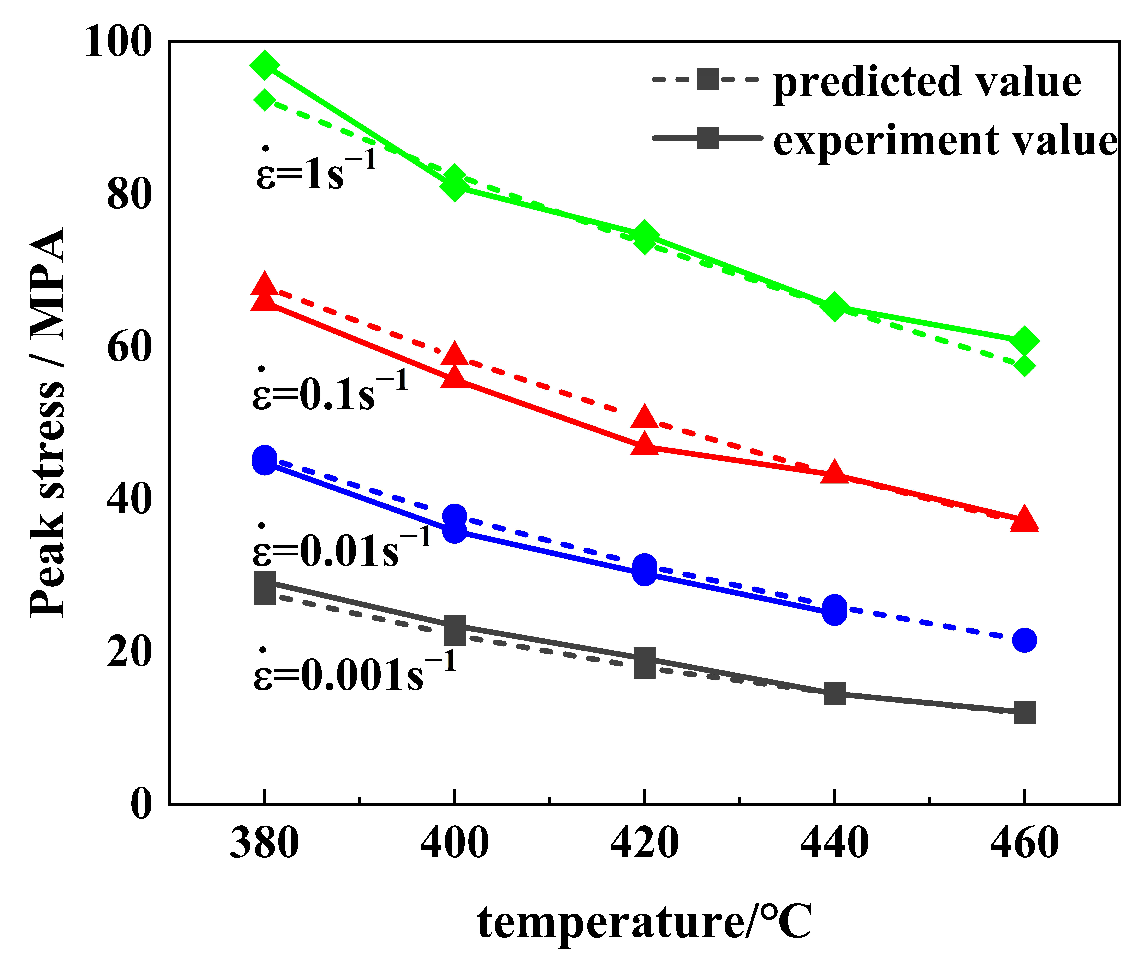
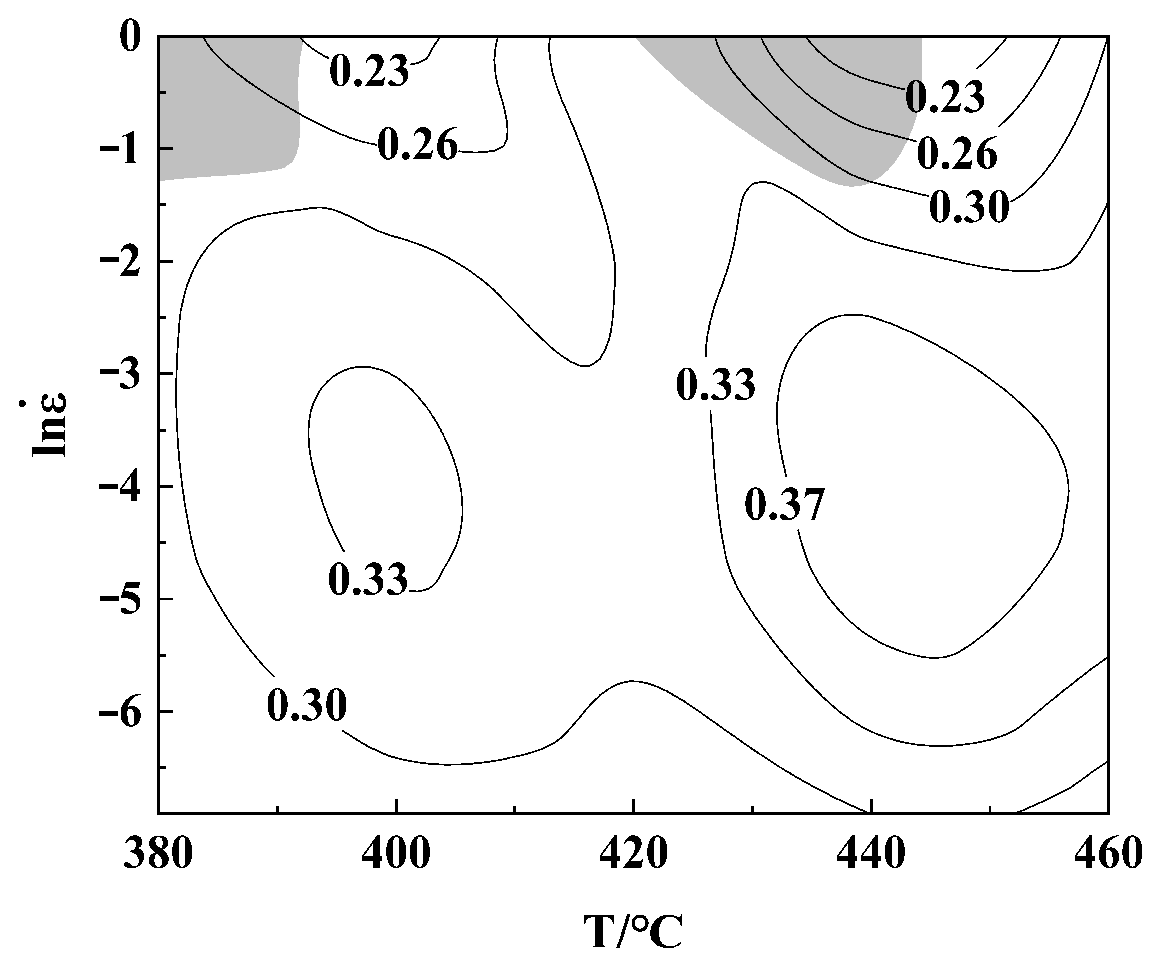


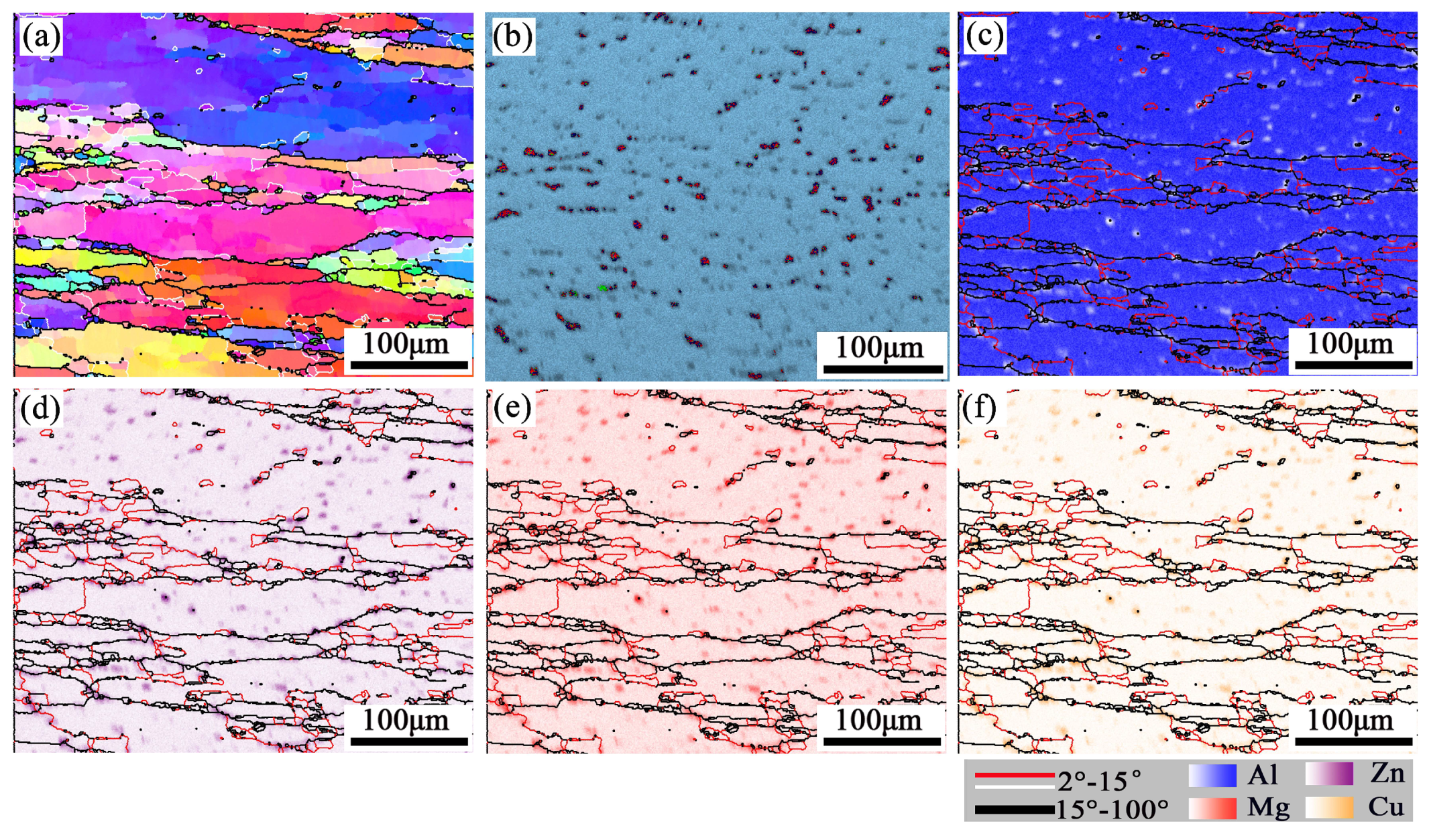
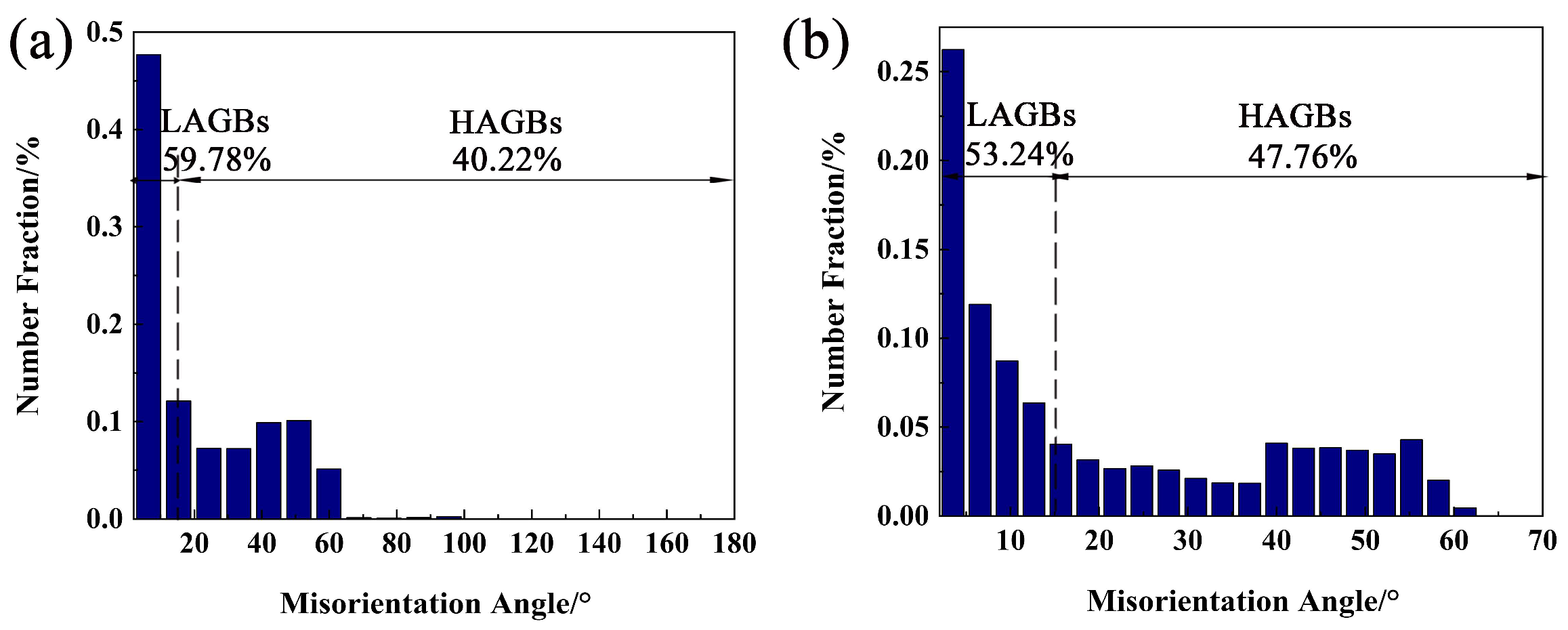
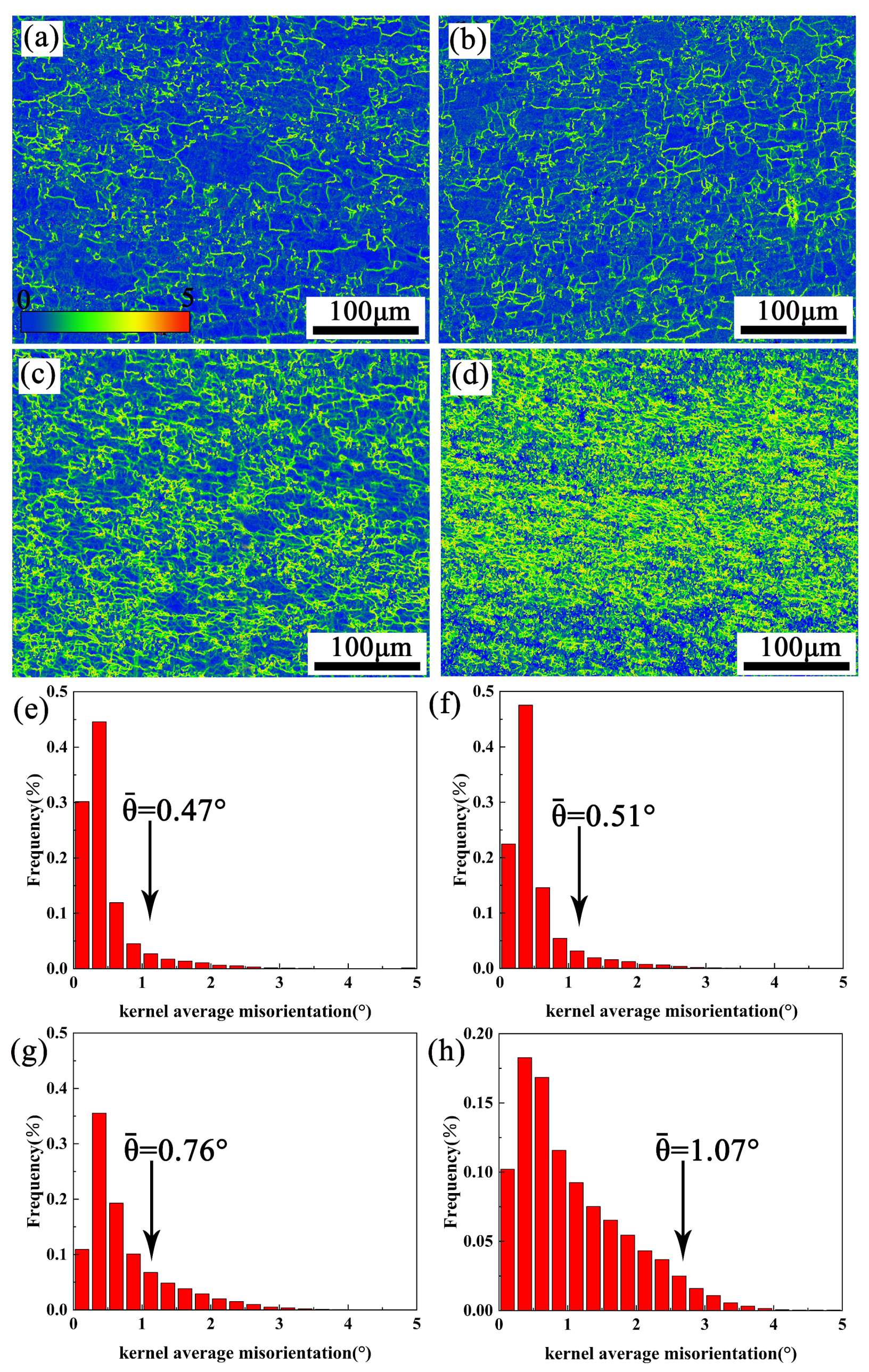

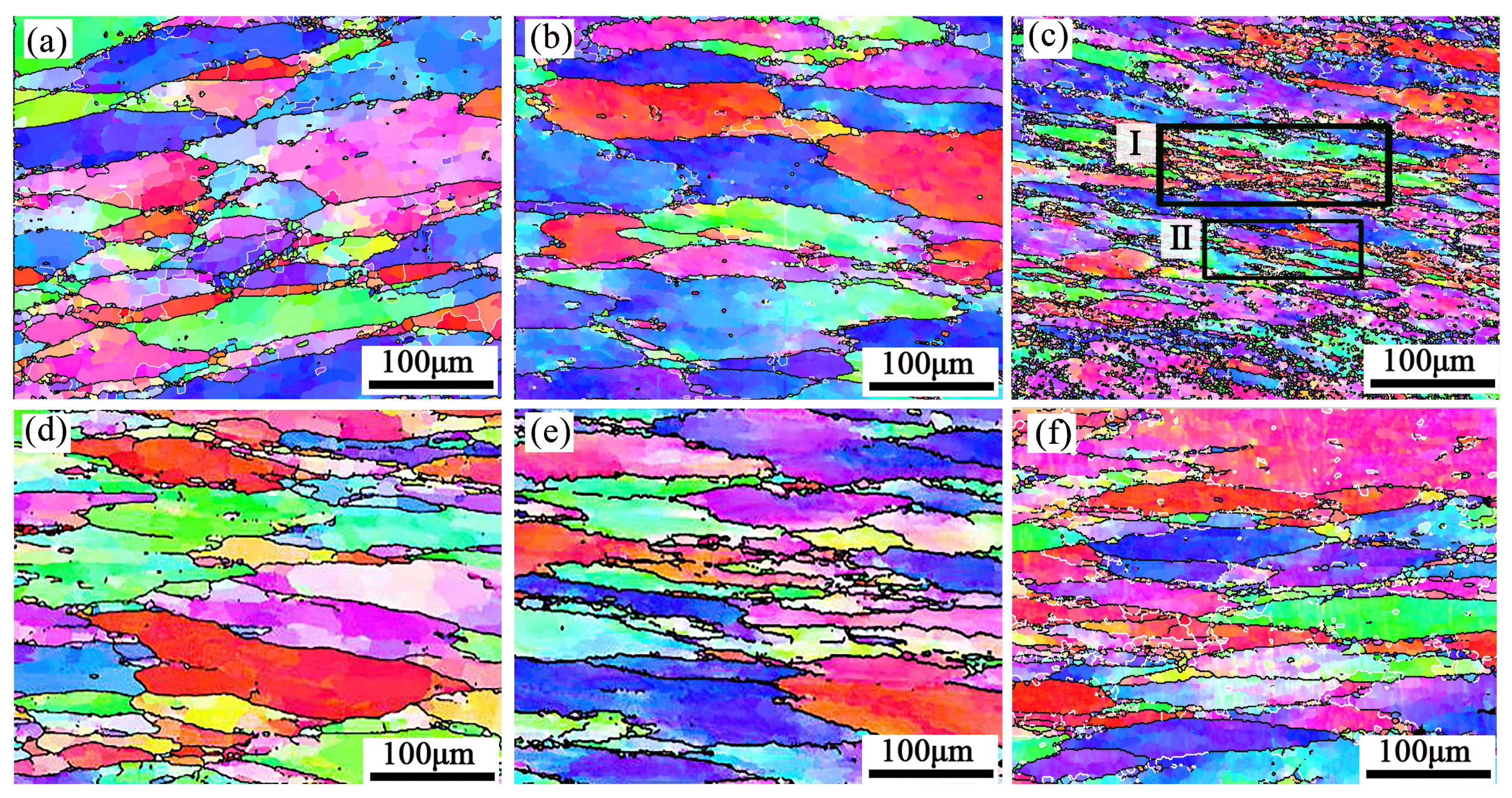

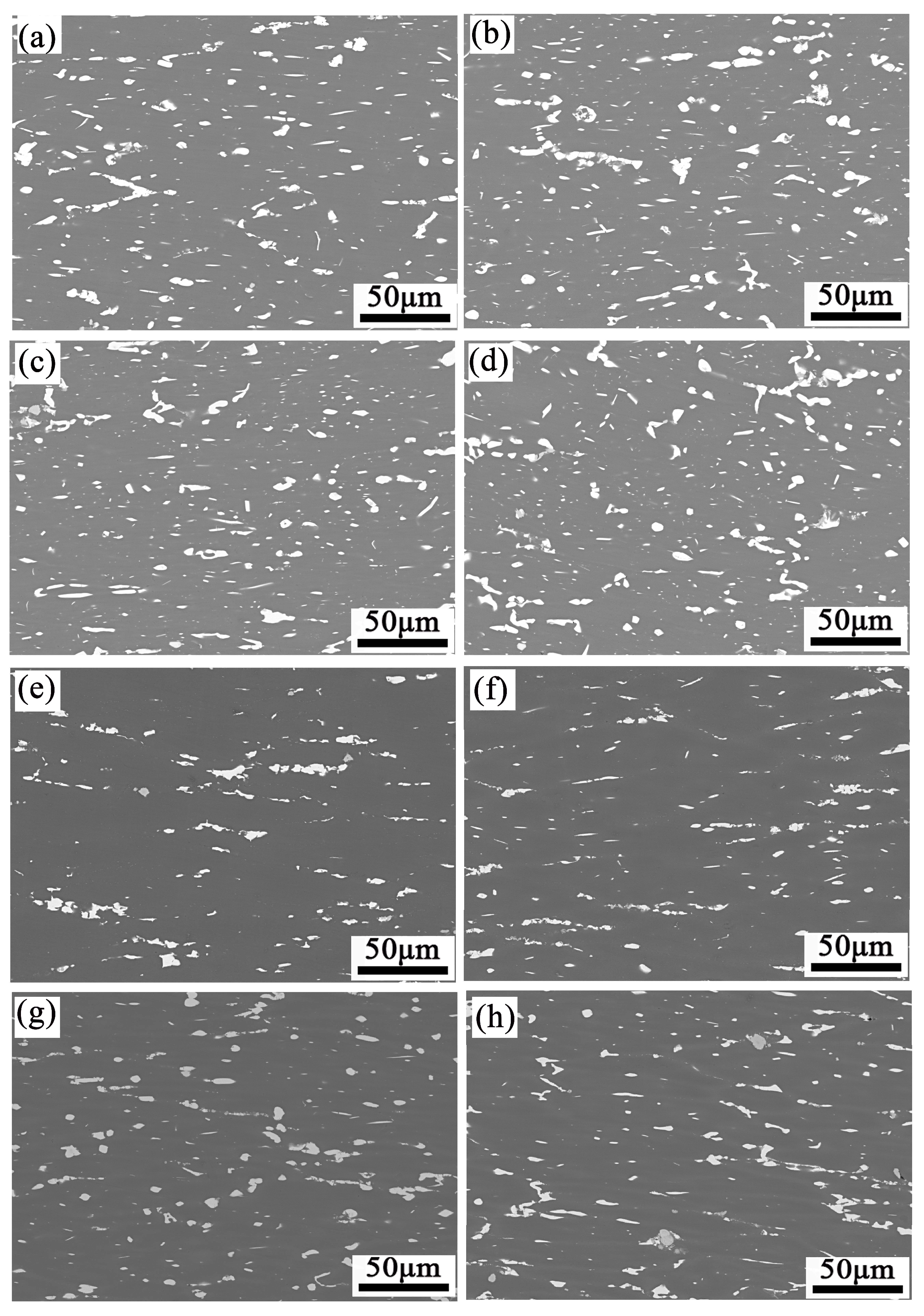
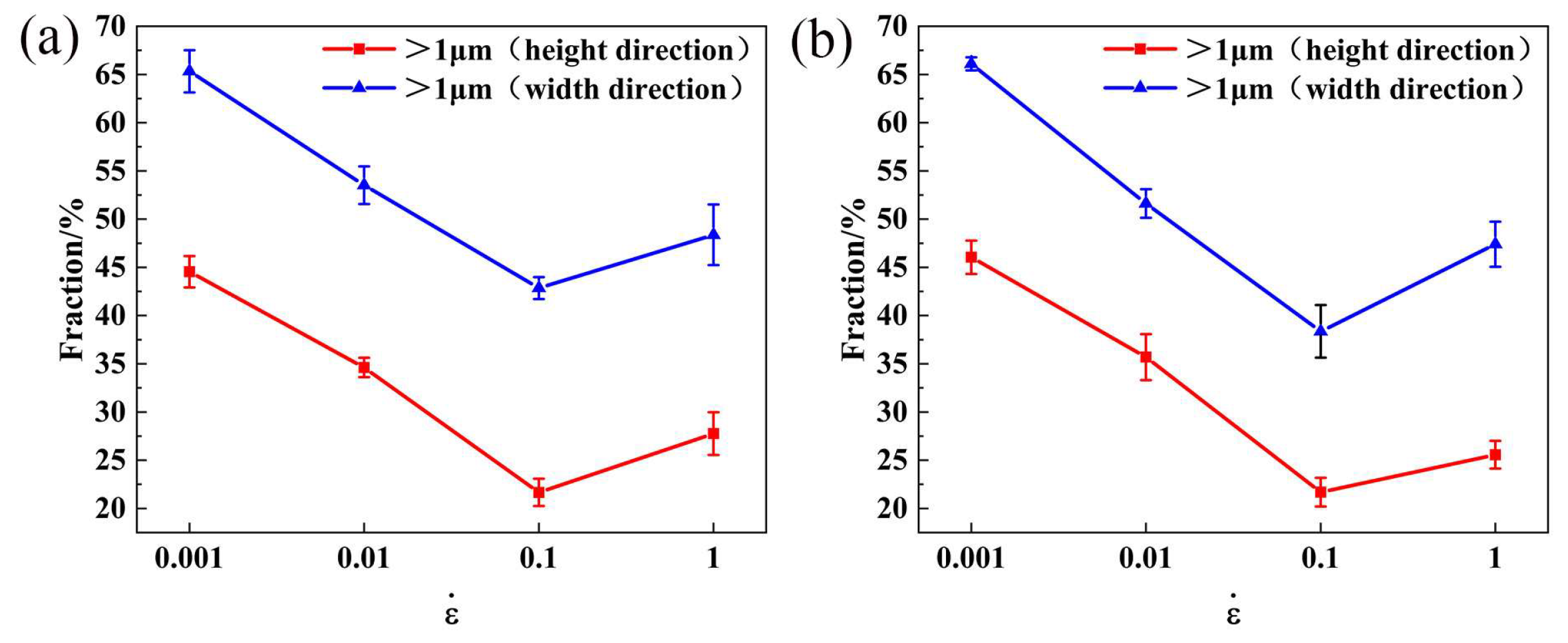
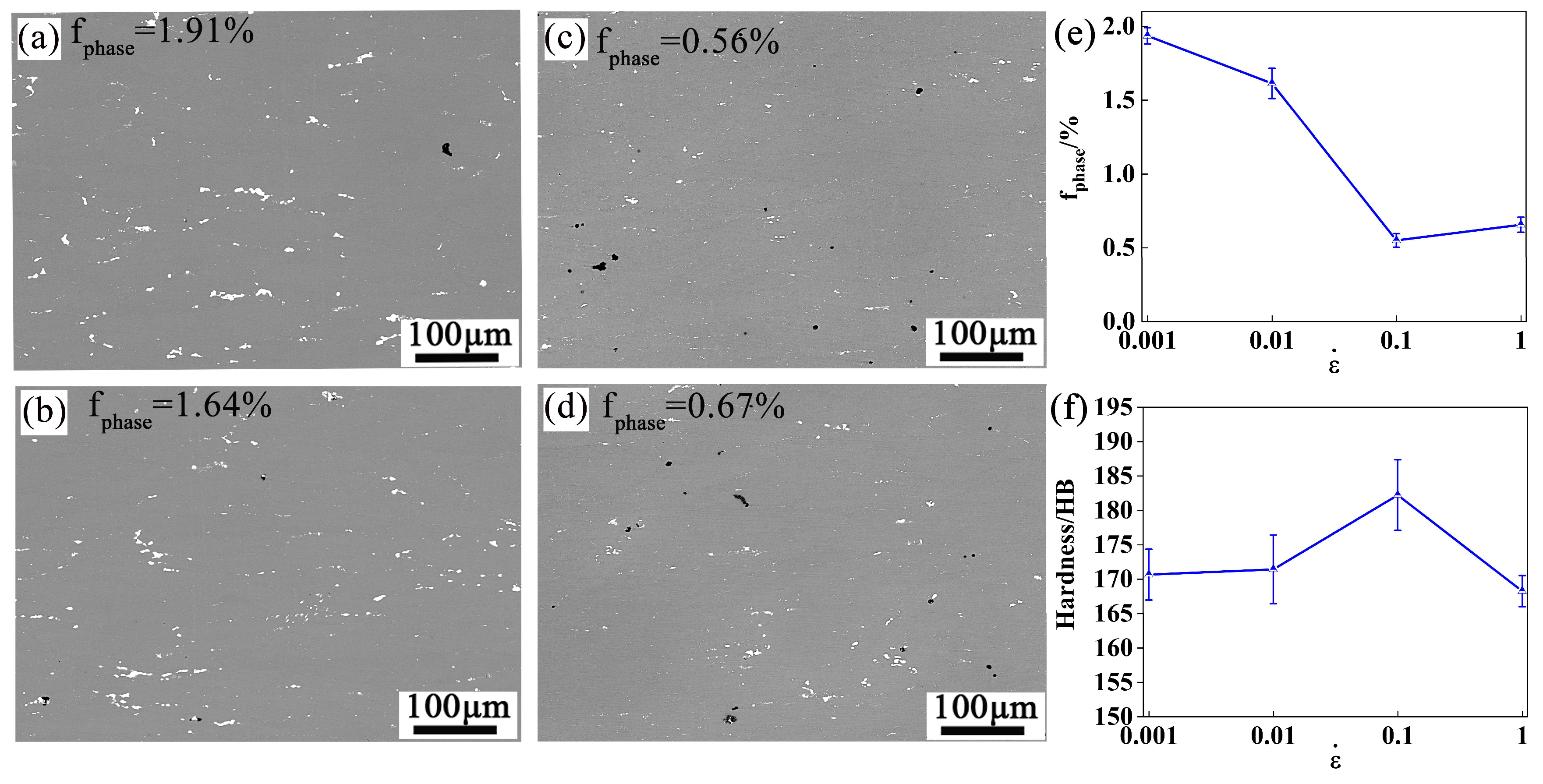
| Mg | Si | Cu | Zn | Zr | Fe | Al |
|---|---|---|---|---|---|---|
| 3.0 | 0.03 | 2.8 | 10 | 0.15 | 0.06 | Bal. |
| β | n | A | Q (KJ/mol) | A |
| 0.12 | 3.72 | 0.0242 | 160.43 (380–460 °C) | 2.38 × 1010 |
| /S−1 | 0.001 | 0.01 | 0.1 | 1 | |
|---|---|---|---|---|---|
| T/°C | |||||
| 380 | 5.06 × 1015 | 5.49 × 1015 | 8.18 × 1015 | 11.51 × 1016 | |
| 440 | 5.81 × 1015 | 5.71 × 1015 | 8.39 × 1015 | 12.56 × 1016 | |
| /S−1 | 0.001 | 0.01 | 0.1 | 1 | |
|---|---|---|---|---|---|
| T/°C | |||||
| 380 | 18 | 19.5 | 23.4 | 26.9 | |
| 440 | 18.7 | 22.3 | 23.8 | 24.2 | |
Disclaimer/Publisher’s Note: The statements, opinions and data contained in all publications are solely those of the individual author(s) and contributor(s) and not of MDPI and/or the editor(s). MDPI and/or the editor(s) disclaim responsibility for any injury to people or property resulting from any ideas, methods, instructions or products referred to in the content. |
© 2023 by the authors. Licensee MDPI, Basel, Switzerland. This article is an open access article distributed under the terms and conditions of the Creative Commons Attribution (CC BY) license (https://creativecommons.org/licenses/by/4.0/).
Share and Cite
Wang, S.-Q.; Zhao, X.; Ren, X.-W.; Zhang, Z.-M.; Tian, X.-D.; He, Y.-Y. Hot Deformation Behavior and Processing Map Considering Strengthening Effect for Al–10.0Zn–3.0Mg–2.8Cu Alloy. Materials 2023, 16, 1880. https://doi.org/10.3390/ma16051880
Wang S-Q, Zhao X, Ren X-W, Zhang Z-M, Tian X-D, He Y-Y. Hot Deformation Behavior and Processing Map Considering Strengthening Effect for Al–10.0Zn–3.0Mg–2.8Cu Alloy. Materials. 2023; 16(5):1880. https://doi.org/10.3390/ma16051880
Chicago/Turabian StyleWang, Si-Qi, Xi Zhao, Xian-Wei Ren, Zhi-Min Zhang, Xue-Dong Tian, and Ya-Yun He. 2023. "Hot Deformation Behavior and Processing Map Considering Strengthening Effect for Al–10.0Zn–3.0Mg–2.8Cu Alloy" Materials 16, no. 5: 1880. https://doi.org/10.3390/ma16051880





